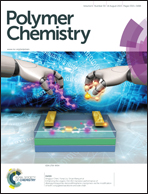Polyanhydride nanoparticles by ‘click’ thiol–ene polymerization†
Abstract
The production of degradable polyanhydride-based nanoparticles using thiol–ene ‘click’ polymerizations is described. Linear polyanhydrides with number-average molecular weights of several thousand g mol−1 were efficiently made through radical-mediated thiol–ene polymerization of 1,6-hexanethiol (HDT) and/or 3,5-dioxa-1,8-dithiooctane (EGDT), and 4-pentenoic anhydride (PNA). These linear polyanhydrides were used in the production of nanoparticles with diameters in the range of 250–400 nm using the emulsion-solvent evaporation method. The degradation of the particles were followed over 3–4 days, and show that hydrolysis of the anhydride moiety in the backbone occurs, decreasing the molecular weight of the polymer and reducing particle stability.


 Please wait while we load your content...
Please wait while we load your content...